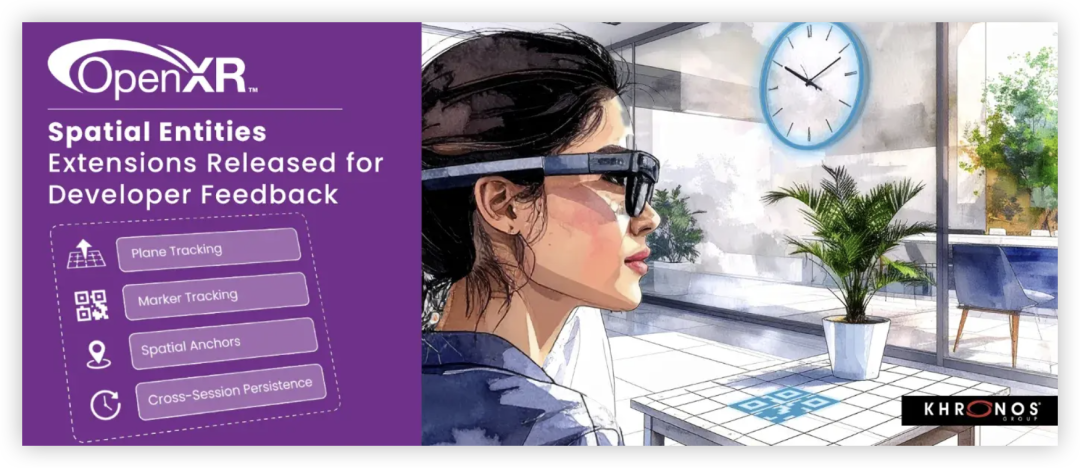Aiming for the Future! OpenXR Launches the 'Universal Language' of Spatial Computing

If you know a bit about Extended Reality (XR) technology, you've probably heard these terms - VR, AR, MR. They represent not just technology, but a window to the future. But what has long troubled developers? Yes, it's the fragmentation and repetitive work in cross-platform development. This time, the Khronos Group's improvements to OpenXR are pushing towards a more imaginative interactive space like a key puzzle piece.
Breaking Through: Taking Cross-Platform Interoperability Further
Yes, the "barriers" between platforms are indeed frustrating. The same functionality might require different code implementations for each hardware manufacturer and system. It's like having different plugs for each device in your home, with no unified standard. But recently, the Khronos® OpenXR™ Working Group officially released Spatial Entities Extensions, providing unified API interfaces that allow developers to build highly compatible portable XR spatial applications.
This combination is like lighting a "capillary" for AR, VR, and MR technologies: you don't need to specifically adapt to each system, but rather build around a "basic driver" provided by Khronos, with extension packages that can run persistent spatial applications directly on different hardware, greatly saving development time and costs.
You might wonder, what kind of revolution is this? Let me tell you about some things you might not have considered yet.
Spatial Computing: Not Just Virtual Content Placement, but "Embedding in Reality"
Spatial Entities Extensions will help you create precise interactions between virtual content and the real world through an extensible, queryable framework. For example:
- • Tracking floors or walls in physical environments to generate "electronic tiles";
- • Recognizing visual markers (like QR codes) in real-world scenes, maintaining precise 6-degree-of-freedom tracking;
- • You can even "pin" a virtual scene one evening and accurately restore it the next morning.
Does this sound like magic? Actually, Khronos has given it a name: persistent, shared, and perceptive XR experiences. Simply put, it's about consistently generating "virtual world anchors" across various devices. To use an analogy: previous development was like everyone drawing the same map in their own way; now, it's like everyone sharing the same paper with unified coordinates.
Industry Response: Ecosystem Starting to Shine
This isn't just Khronos's solo performance. XR industry leaders like China's PICO (ByteDance), Google, Meta, Collabora, and Godot Engine are actively participating in discussions and technical promotion. PICO stated that they provided key contributions and runtime support in this extension; Google and Meta praised this open standard for potentially improving industry efficiency and innovation speed; Godot Engine even said, "This standard is the 'light of the future' we're willing to support."
How far are we from a unified standard in the XR world? The responsibility lies with people like us who love technology - participating in open-source project communities to make standards better fit real needs.
2025: Opening the "XR Platform Unification Era"
The new extensions are expected to be implemented first in 2025, providing developers with more experimental tools. For example, image and object tracking capabilities, environmental mesh model generation and processing, etc., become the foundation for another kind of imagination in the future. They gradually bid farewell to the laborious development of "tailoring for single platforms," leaving the focus on more creative interactive experiences.
Final Thoughts: XR, What "Universe" Will It Connect to Next?
OpenXR isn't just about staking territory; it emphasizes building an ecosystem supported by developers. Imagine that from Android devices to high-performance headsets, as long as they're compatible with this standard, you can achieve cross-device calls, permanent content settings, and "precise alignment" with the real world on screen.
XR still has a long way to go, but OpenXR seems to have set up the first scaffolding. The launch of this standard also reminds us that the future "virtual world" isn't just a castle in the air - they're becoming more "grounded" year by year!
分享文章
3篇相关文章
South Korea XR Stuns the World: From Digital Healing to AI Collaboration, Unveiling Eight Pioneers of Future Digital Life
2025-11-03
South Korea's innovation wave in XR, metaverse, and AI is sweeping the globe. This article explores eight Korean pioneers reshaping digital life through cutting-edge tech—from physical and mental wellness to entertainment, smart operations to artistic creation—showcasing the vibrant energy and infinite possibilities of Korea's digital content industry.
This Japanese Company Uses XR to Make Manufacturing Experience 'Digitally Immortal'!
2025-10-15
The future of manufacturing lies in the hands of every craftsman. But the skill transfer gap is becoming a massive obstacle to industry development. Now, a new platform combining cutting-edge MR and 3DGS technology is quietly changing all this.
When Apple Builds Walls, Samsung Chooses to 'Join Forces with Google': The XR Ecosystem War Begins!
2025-10-15
Samsung joins forces with Google, planning a disruptive XR comeback from a completely new ecosystem perspective.